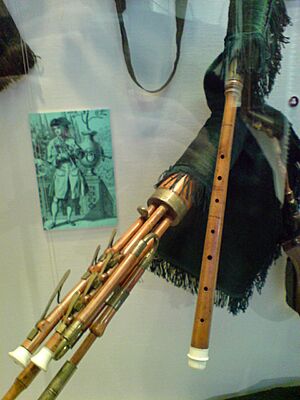Hugh Robertson (instrument maker) facts for kids
Hugh Robertson (1730–1822) was a talented Scottish craftsman. He was known for working with wood and ivory. He was also a master at making woodwind instruments, especially different kinds of bagpipes. These included pastoral pipes, union pipes, and great Highland bagpipes.
Quick facts for kids
Hugh Robertson
|
|
|---|---|
| Born | c 1730 |
| Died | 1822 |
| Occupation | Instrument maker, wood turner, ivory turner |
| Years active | 1765–1821 |
About Hugh Robertson
Hugh Robertson was born around 1730 in Scotland. We don't know the exact date. He likely grew up in Edinburgh, where he lived and worked for most of his life. He retired in 1821 when he was 90 years old.
Robertson is known as one of the first professional pipe makers in Scotland during the 18th century. His career lasted for 58 years! His pipes have a special mark from 1765. By 1775, he was listed in a business directory as a 'pipe maker' in Edinburgh. He made many types of pipes, including the great Highland bagpipes, pastoral pipes, and Union pipes.
Robertson's Instruments

Before 1750, the first companies making bagpipes started in Edinburgh and Glasgow. Skilled wood turners often became instrument makers. They would create instruments with their own special designs. Hugh Robertson was one of these talented makers.
Robertson added unique decorations to his Highland bagpipes. These were called 'beading' and 'combing'. These styles became standard by the late 1700s and are still used today. He even crafted the special Great Highland pipe that won a prize in Edinburgh in 1802. This very pipe was later played by Piper John Buchanan at the famous Battle of Waterloo.
During Robertson's time, plays and shows were very popular. Many gentlemen also enjoyed playing the pipes. This meant there was a demand for high-quality instruments. Robertson made excellent bellows-blown pastoral and union pipes. Many of his pipes with his special mark still exist today. In fact, more of his instruments have survived than those of many other makers from his time.
Robertson used local woods like laburnum, boxwood, and elder. His workshop was in a good spot to get materials from ships. These ships traded in the rivers Clyde and Forth. He also used tropical woods like cocus wood from the Caribbean and Africa. These woods were great for making musical instruments, especially bagpipes.
Robertson was always trying new things. He didn't just use hardwoods. He also experimented with ivory for the bass, baritone, and tenor drones. Many of his pastoral and union pipe sets had a special U-bend in the bass drone. This made the instrument shorter and easier to tune. He also made other changes to Scottish Union pipes. For example, he added a third drone. He also placed the regulators (parts that change the sound) at the front of the instrument. This helped with balance and made the sound louder.
These changes happened as music styles changed. Makers like Robertson would try new ideas to make their instruments better. They shared their knowledge with other makers in Scotland, England, and Ireland. This helped bagpipes become more advanced and refined into the 19th century.
Awards and Recognition
Robertson's instruments were very popular, especially with gentlemen. He made the Edinburgh Great Highland prize pipe in 1802. He also crafted prize pipes for the Highland Society of London between the 1780s and 1820s. This society held piping competitions and ordered pipes from Robertson as prizes. These pipes were used in big Highland culture events at the Theatre Royal in Edinburgh.
Robertson was recognized for his skill and for improving pastoral and union pipes. He even received a set of union pipes from the Duchess of Northumberland. These pipes had belonged to a famous piper named Jamie Allen.

